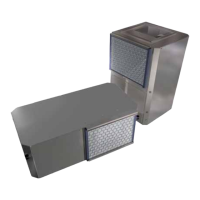6
88-A5PA3001-1A-EN
be calibrated in a refrigerant-free area.) Ensure that
the detector is not a potential source of ignition and
is suitable for the refrigerant used. Leak detection
equipment shall be set at a percentage of the LFL of
the refrigerant and shall be calibrated to the
refrigerant employed, and the appropriate
percentage of gas (25 % maximum) is confirmed.
• Leak detection fluids are also suitable for use with
most refrigerants but the use of detergents
containing chlorine shall be avoided as the chlorine
may react with the refrigerant and corrode the
copper pipe-work.
Example of leak detection fluids are:
• Bubble method,
• Fluorescent method agents
If a leak is suspected, all naked flames shall be
removed/extinguished.
If a leakage of refrigerant is found which requires
brazing, all of the refrigerant shall be recovered from
the system, or isolated (by means of shut off valves) in
a part of the system remote from the leak.
Removal and Evacuation
When breaking into the refrigerant circuit to make
repairs - or for any other purpose - conventional
procedures shall be used. However, for flammable
refrigerants it is important that best practice be
followed, since flammability is a consideration. The
following procedure shall be adhered to:
• Safely remove refrigerant following local and
national regulations;
• Evacuate;
• Purge the circuit with inert gas;
• Evacuate;
• Continuously flush or purge with inert gas when
using flame to open circuit;
• And open the circuit.
The refrigerant charge shall be recovered into the
correct recovery cylinders if venting is not allowed by
local and national codes. For appliances containing
flammable refrigerants, the system shall be purged
with oxygen-free nitrogen to render the appliance safe
for flammable refrigerants.
This process might need to be repeated several times.
Compressed air or oxygen shall not be used for
purging refrigerant systems.
For appliances containing flammable refrigerants,
refrigerants purging shall be achieved by breaking the
vacuum in the system with oxygen-free nitrogen and
continuing to fill until the working pressure is achieved,
then venting to atmosphere, and finally pulling down
to a vacuum. This process shall be repeated until no
refrigerant is within the system. When the final oxygen-
free nitrogen charge is used, the system shall be
vented down to atmospheric pressure to enable work
to take place.
The outlet for the vacuum pump shall not be close to
any potential ignition sources, and ventilation shall be
available.
Charging Procedures
In addition to conventional charging procedures, the
following requirements shall be followed.
• Ensure that contamination of different refrigerants
does not occur when using charging equipment.
Hoses or lines shall be as short as possible to
minimise the amount of refrigerant contained in
them.
• Cylinders shall be kept in an appropriate position
according to the instructions.
• Ensure that the refrigerating system is earthed prior
to charging the system with refrigerant.
• Label the system when charging is complete (if not
already).
• Extreme care shall be taken not to overfill the
refrigerating system.
Prior to recharging the system, it shall be pressure-
tested with the appropriate purging gas. The system
shall be leak-tested on completion of charging but prior
to commissioning. A follow up leak test shall be carried
out prior to leaving the site.
Important: The unit should not be tested higher than 450 psig
for servicing or component replacement.
See installation instructions below for further details.
Recovery
When removing refrigerant from a system, either for
servicing or decommissioning, it is recommended
good practice that all refrigerants are removed safely.
When transferring refrigerant into cylinders, ensure
that only appropriate refrigerant recovery cylinders are
employed. Ensure that the correct number of cylinders
for holding the total system charge is available. All
cylinders to be used are designated for the recovered
refrigerant and labelled for that refrigerant (i.e., special
cylinders for the recovery of refrigerant). Cylinders
shall be complete with pressure-relief valve and
associated shut-off valves in good working order.
Empty recovery cylinders are evacuated and, if
possible, cooled before recovery occurs.
The recovery equipment shall be in good working
order with a set of instructions concerning the
equipment that is at hand and shall be suitable for the
recovery of the flammable refrigerant. If in doubt, the
manufacturer should be consulted. In addition, a set of
calibrated weighing scales shall be available and in
IInnffoorrmmaattiioonn oonn SSeerrvviicciinngg

